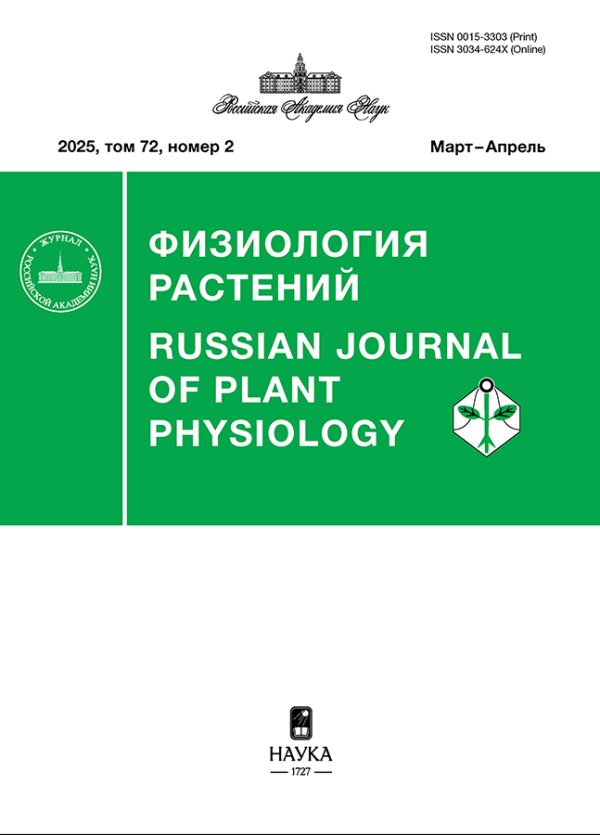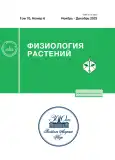Growth and Physiological State of Microalgae Heterosigma akashiwo (Raphidophyceae) during Exposure to Cadmium, Lead, and Nickel
- Authors: Markina Z.V.1, Ognistaya A.V.2,1
-
Affiliations:
- Zhirmunsky National Research Center of Marine Biology, Far Eastern Branch, Russian Academy of Sciences
- Far Eastern Federal University
- Issue: Vol 70, No 6 (2023)
- Pages: 670-678
- Section: ЭКСПЕРИМЕНТАЛЬНЫЕ СТАТЬИ
- URL: https://journals.rcsi.science/0015-3303/article/view/232812
- DOI: https://doi.org/10.31857/S0015330323600298
- EDN: https://elibrary.ru/ONEXCE
- ID: 232812
Cite item
Full Text
Abstract
The effect of heavy metals cadmium, lead, and nickel on the growth and physiological state of raphidophyte algae Heterosigma akashiwo MBRU_HAK-SR11 (Y. Hada) Y. Hada ex Y. Hara, M. Chihara during 7 days of experiments has been assessed. It was found that cadmium and nickel at concentrations of 10 and 20 µg/L stimulated H. akashiwo growth, while lead inhibited it at these concentrations. Chlorophyll a and carotenoids content increased with the addition of 10 μg/L of cadmium and 20 μg/L of nickel, and the content of carotenoids was higher than that in the control with the addition of 20 μg/L of cadmium. With the introduction of lead, an increase in the level of chlorophyll a and a decrease in the content of carotenoids were observed. The content of ROS increased with the introduction of cadmium and lead and decreased with the introduction of nickel. Cadmium had an effect on the production of neutral lipids: their content increased and decreased by the end of the experiment. Nickel stimulated the accumulation of neutral lipids H. akashiwo, while lead had no effect on their content. Metals had the least effect on forward and side light scattering and fluorescence of chlorophyll a. The absence of pronounced changes in direct and lateral light scattering indirectly indicates that the algae cells did not change morphologically under toxic exposure. Thus, cadmium, lead, and nickel at concentrations of 10–20 µg/L changed physiological processes in algae.
About the authors
Zh. V. Markina
Zhirmunsky National Research Center of Marine Biology, Far Eastern Branch, Russian Academy of Sciences
Email: zhannav@mail.ru
Vladivostok, Russia
A. V. Ognistaya
Far Eastern Federal University; Zhirmunsky National Research Center of Marine Biology, Far Eastern Branch, Russian Academy of Sciences
Author for correspondence.
Email: zhannav@mail.ru
Vladivostok, Russia; Vladivostok, Russia
References
- Nagajyoti P.C., Lee K.D., Sreekanth T.V.M. Heavy metals, occurrence and toxicity for plants: a review // Environ. Chem. Lett. 2010. V. 8. P. 199. https://doi.org/10.1007/s10311-010-0297-8
- Masmoudi S., Nguyen-Deroche N., Caruso A., Ayadi H., Morant-Manceau A., Tremblin G. Cadmium, copper, sodium and zinc effects on diatoms: from heaven to hell – a review // Cryptogam., Algol. 2013. V. 34. P. 185. https://doi.org/10.7872/crya.v34.iss2.2013.185
- Huang X.G., Li S.X., Liu F.J., Lan W.R. Regulated effects of Prorocentrum donghaiense Lu exudate on nickel bioavailability when cultured with different nitrogen sources // Chemosphere. 2018. V. 197. P. 57. https://doi.org/10.1016/j.chemosphere.2018.01.014
- Cheng J., Qiu H., Chang Z., Jiang Z., Yin W. The effect of cadmium on the growth and antioxidant response for freshwater algae Chlorella vulgaris // SpringerPlus. 2016. V. 5. P. 1. https://doi.org/10.1186/s40064-016-2963-1
- Andosch A., Affenzeller M.J., Lütz C., Lütz-Meindl U. A freshwater green alga under cadmium stress: ameliorating calcium effects on ultrastructure and photosynthesis in the unicellular model Micrasterias // J. Plant Physiol. 2012. V. 169. P. 1489. https://doi.org/10.1016/j.jplph.2012.06.002
- Mallick N., Mohn F.H. Use of chlorophyll fluorescence in metal-stress research: a case study with the green microalga Scenedesmus // Ecotoxicol. Environ. Saf. 2003. V. 55. P. 64. https://doi.org/10.1186/10.1016/S0147-6513(02)00122-7
- Chia M.A., Lombardi A.T., Maria da Graça G.M., Parrish C.C. Lipid composition of Chlorella vulgaris (Trebouxiophyceae) as a function of different cadmium and phosphate concentrations // Aquat. Toxicol. 2013. V. 128. P. 171. https://doi.org/10.1016/j.aquatox.2012.12.004
- Jamers A., Blust R., De Coen W., Griffin J.L., Jones O.A. An omics based assessment of cadmium toxicity in the green alga Chlamydomonas reinhardtii // Aquat. Toxicol. 2013. V. 126. P. 355. https://doi.org/10.1016/j.aquatox.2012.09.007
- Martínez-Ruiz E.B., Martínez-Jerónimo F. Nickel has biochemical, physiological, and structural effects on the green microalga Ankistrodesmus falcatus: an integrative study // Aquat. Toxicol. 2015. V. 169. P. 27. https://doi.org/10.1016/j.aquatox.2015.10.007
- Li M., Zhang F., Glibert P.M. Seasonal life strategy of Prorocentrum minimum in Chesapeake Bay, USA: Validation of the role of physical transport using a coupled physical–biogeochemical–harmful algal bloom model // Limnol. Oceanogr. 2021. V. 66. P. 3873. https://doi.org/10.1002/lno.11925
- Маркина Ж.В. Ультраструктура и автотрофная функция клеток рафидофитовой микроводоросли Heterosigma akashiwo (Y. Hada) Y. Hada ex Y. Hara and M. Chihara, 1987 в загрязненной медью среде // Биология моря. 2021. Т. 47. С. 196. https://doi.org/10.31857/S0134347521030074
- Lemley D.A., Adams J.B., Rishworth G.M., Purdie D.A. Harmful algal blooms of Heterosigma akashiwo and environmental features regulate Mesodinium cf. rubrum abundance in eutrophic conditions // Harmful Algae. 2020. 100:101943. https://doi.org/10.1016/j.hal.2020.101943
- Bornman E., Adams J.B., Strydom N.A. Algal blooms of Heterosigma akashiwo and Mugilidae Gill Alterations // Estuaries Coast. 2022. V. 45. P. 1674. https://doi.org/10.1007/s12237-021-01038-6
- La Rocca N., Andreoli C., Giacometti G.Á., Rascio N., Moro I. Responses of the Antarctic microalga Koliella antarctica (Trebouxiophyceae, Chlorophyta) to cadmium contamination // Photosynthetica. 2009. V. 47. P. 471. https://doi.org/10.1007/s11099-009-0071-y
- Carfagna S., Lanza N., Salbitani G., Basile A., Sorbo S., Vona V. Physiological and morphological responses of lead or cadmium exposed Chlorella sorokiniana 211-8K (Chlorophyceae) // SpringerPlus. 2013. V. 2. P. 1. https://doi.org/10.1186/2193-1801-2-147
- Zamani-Ahmadmahmoodi R., Malekabadi M.B., Rahimi R., Johari S.A. Aquatic pollution caused by mercury, lead, and cadmium affects cell growth and pigment content of marine microalga, Nannochloropsis oculata // Environ. Monit. Assess. 2020. V. 192. P. 1. https://doi.org/10.1007/s10661-020-8222-5
- Gomes A., Ferdandes E., Lima J.F.L.C. Fluorescence probes used for detection of reactive oxygen species // J. Biophys. Biochem. Methods. 2005. V. 65. P. 45. https://doi.org/10.1016/j.jbbm.2005.10.003
- Wan M., Jin X., Xia J., Rosenberg J.N., Yu G., Nie Z., Oyler G.A., Betenbaugh M.J. The effect of iron on growth, lipid accumulation, and gene expression profile of the freshwater microalga Chlorella sorokiniana // Appl. Microbiol. Biotechnol. 2014. V. 98. P. 9473. https://doi.org/0.1007/s00253-014-6088-6
- Rajabi Islami H., Assareh R. Effect of different iron concentrations on growth, lipid accumulation, and fatty acid profile for biodiesel production from Tetradesmus obliquus // J. Appl. Phycol. 2019. V. 31 P. 3421. https://doi.org/10.1007/s10811-019-01843-4
- Guillard R.R.L., Ryther J.H. Studies of marine planktonic diatoms. 1. Cyclotella nana Hustedt and Detonula confervacea (Cleve) Gran. // Can. J. Microbiol. 1962. V. 8. P. 229. https://doi.org/10.1139/m62-029
- Hyka P., Lickova S., Přibyl P., Melzoch K., Kovar K. Flow cytometry for development of biotechnological processes with microalgae // Biotechnol. Adv. 2013. V. 31. P. 2. https://doi.org/10.1016/j.biotechadv.2012.04.007
- Alemán-Nava G.S., Cuellar-Bermudez S.P., Cuaresma M., Bosma R., Muylaert K., Ritmann B.E., Parra R. How to use Nile Red, a selective fluorescent stain for microalgal neutral lipids // J. Microbiol. Methods. 2016. V. 128. P. 74. https://doi.org/10.1016/j.mimet.2016.07.011
- Jeffrey S.T., Humphrey G.F. New spectrophotometric equations for determining chlorophylls a, b, c1 and c2 in higher plants, algae and natural phytoplankton // Biochem. Physiol. Pflanz. 1975. V. 167. P. 191. https://doi.org/10.1016/S0015-3796(17)30778-3
- Zhu Q.L., Guo S.N., Wen F., Zhang X.L., Wang C.C., Si L.F., Zeng J.L., Liu J. Transcriptional and physiological responses of Dunaliella salina to cadmium reveals time-dependent turnover of ribosome, photosystem, and ROS-scavenging pathways // Aquat. Toxicol. 2019. V. 207. P. 153. https://doi.org/10.1016/j.aquatox.2018.12.007
- Gissi F., Adams M.S., King C.K., Jolley D.F. A robust bioassay to assess the toxicity of metals to the Antarctic marine microalga Phaeocystis Antarctica // Environ. Toxicol. Chem. 2015. V. 34. P. 1578. https://doi.org/10.1002/etc.2949
- Dobrikova A.G., Apostolova E.L. Damage and protection of the photosynthetic apparatus under cadmium stress // Cadmium toxicity and tolerance in plants / Eds. M. Hasanuzzaman et al. Academic Press. 2019. P. 275. https://doi.org/10.1016/B978-0-12-814864-8.00011-5
- Singh M., Kumar J., Singh S., Singh V.P., Prasad S.M., Singh M.P.V.V.B. Adaptation strategies of plants against heavy metal toxicity: a short review // Biochem. Pharmacol. 2015. V. 4. P. 2167. https://doi.org/10.4172/2167-0501.1000161
- Barkhordari A.Z., Taherizadeh M.R., Yousef Z.M. Effects of different concentrations of lead on growth, photosynthetic pigmentation and protein micro alga Isochrysis galbana // J. Oceanogr. 2021. V. 12. P. 109. https://doi.org/10.52547/joc.12.46.109
- Shanab S., Essa A., Shalaby E. Bioremoval capacity of three heavy metals by some microalgae species (Egyptian Isolates) // Plant Signal. Behav. 2012. V. 7. P. 392. https://doi.org/10.4161/psb.19173
- Kumar K.S., Dahms H.U., Won E.J., Lee J.S., Shin K.H. Microalgae – a promising tool for heavy metal remediation // Ecotoxicol. Environ. Saf. 2015. V. 113. P. 329. https://doi.org/10.1016/j.ecoenv.2014.12.019
- Kemer K., Mantiri D.M., Rompas R.M., Rimper J.R., Margyaningsih N.I. Transmission electron microscope analysis upon growth of lead acetate treated microalga, Dunaliella sp. // Aquac. Aquar. Conserv. Legis. 2020. V. 13. P. 849.
- Dao L.H., Beardall J. Effects of lead on two green microalgae Chlorella and Scenedesmus: photosystem II activity and heterogeneity // Algal Res. 2016. V. 16. P. 150. https://doi.org/10.1016/j.algal.2016.03.006
- Moise M.M. Lead (Pb2+) causes chlorophyll related changes and oxidative damage in Chlorella ellipsoides (Chlorophyceae) // Braz. J. Biol. Sci. 2019. V. 6. P. 605. https://doi.org/10.21472/bjbs.061412
- Hong H.S., Wang M.H., Huang X.G., Wang D.Z. Effects of macronutrient additions on nickel uptake and distribution in the dinoflagellate Prorocentrum donghaiense Lu // Environ. Pollut. 2009. V. 157. P. 1933. https://doi.org/10.1016/j.envpol.2009.01.009
- Guo R., Lu D., Liu C., Hu J., Wang P., Dai X. Toxic effect of nickel on microalgae Phaeodactylum tricornutum (Bacillariophyceae) // Ecotoxicology. 2022. V. 31. P. 746. https://doi.org/10.1007/s10646-022-02532-8
Supplementary files













